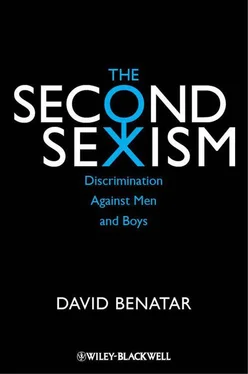Perhaps my opponents think that although we do use words like “sexism” and “racism” in these ways we should not do so. Perhaps they are recommending that we alter our usage and use the word “sexism” in a more restricted way. These definitional issues are difficult. We cannot categorically say that ordinary usage must prevail. Such usage is sometimes both confused and confusing. However, it is not clear that this is true in the case at hand. Moreover, there is a danger in stipulative definitions that depart too significantly from ordinary usage. They themselves can be confusing or misleading. If, to choose an extreme example, one defines Monday as the day after Tuesday, one will not be contributing positively to clearer thinking and communication.
It is possible to stipulate that males cannot be the victims of sexism or, less blatantly, that group members cannot be victims of sexism or racism unless those groups are disempowered or subordinated. However, it is hard to see why such stipulations should be made. Indeed, doing so seems to have implications that would be unpalatable even to many of those who make them. A racial epithet directed against a rich and powerful member of the Kenyan government would widely and rightly be recognized as racist, even though the epithet would not lead to an overall disempowerment or subordination of blacks in Kenya. Nor does the target group need to be a majority. Jews in the United States, for example, today enjoy a degree of equality and influence unprecedented in Jewish history. They are not (contrary to the view of some antisemites) controlling the country, but they are hardly disempowered or subordinated. Isolated anti-Jewish epithets in the United States do not plausibly effect an overall disempowering or subordination of Jews in that country, but they would nonetheless appropriately be recognized as instances of antisemitism.
In response to these examples, perhaps it will be suggested that they are instances of racism and antisemitism because there is a history of discrimination against blacks and Jews. According to this view, it does not matter whether, in a given place, that pattern of discrimination continues. It is sufficient that it did previously continue for a long time. Notice, however, that this pedigree criterion of racism and antisemitism is even more controversial than the other features of the alternative definitions I reject.
There is a further problem with stipulating that only disempowered, subordinate or oppressed groups can be the victims of sexism (or racism). It may well be the case that females are no longer systematically disempowered, subordinated or oppressed in developed countries. Many feminists will be outraged at this suggestion. I shall delay, until the concluding chapter, my defense of this suggestion. For now, it is sufficient to make two observations.
First, power is spectral rather than binary. One has more or less of it, rather than either having it or not having it. Accordingly, even if men still have overall power in the developed world, the erosion of male power has taken place gradually. On this trajectory, there comes a point at which men no longer hold most power and at which women, while still the victims of discrimination, are no longer subordinated or dominated. Those who assert that the term “sexism” only applies where one group is dominant or another subordinate must concede that discrimination against females would not constitute sexism once that point is reached. I find that implausible. If my critics recognized that that point had already been reached in some places, they would likely find it implausible too.
Second, some feminists have recognized that to say, for example, that women in the developed world are still oppressed, they must depart from the traditional understanding of “oppression” and employ a new understanding of this term. 23 23 Iris Marion Young, Justice and the Politics of Difference , pp. 40–41. I shall discuss these issues further in the final chapter.
In this way the definitional questions recur. We are asked to reinterpret “sexism” in such a way that oppression is a criterion for it, but then we are asked to reinterpret “oppression” in such a way that the word “sexism” can still be applied to contexts in which it still seems to have application. With all this reinterpretation that is required, one wonders why it would not be more economical — and truer to ordinary usage — just to stick with the common understanding of “sexism.”
I have now presented and rejected some representative alternatives to my understanding of sexism. It is worth noting, however, that less rests on this disagreement than might first appear. Let us assume, merely for the sake of argument, that sexism should not be understood in the way I have suggested it should be understood. And let us assume further that for this reason men cannot be the victims of sexism. If that were the case then there could be no second sexism . However, nothing would follow from this about a second sex discrimination . Men and boys could still be the victims of wrongful sex discrimination. 24 24 And if anybody objects to that term, we might simply say that they are the victims of injustice, or simply that they are wrongly treated.
Even if that were not appropriately called sexism it would still be worthy of moral concern and opposition. Wrongful discrimination is wrongful and could be quite seriously so. Thus the really important conclusion for which I need to argue is that males are the victims of wrongful discrimination (or even merely wrongful treatment) on the basis of their sex. I happen to think that such discrimination merits the name “sexism” but even if I were incorrect about that, my critics could not justify, on that basis, any complacency about the wrongful discrimination of which males are the victims. 25 25 Some might suggest that if females are the greater victims of sex discrimination than males that we are, on that basis, justified in focusing on anti-female sex discrimination. I reject that argument in the “Distraction” section of Chapter 5.
It would still be a problem that should be recognized and confronted. It is much more important that wrongful discrimination against men and boys be identified and opposed than that we call it “sexism.” The fact that labeling wrongful discrimination as “sexism” is not essential to its being wrong and worthy of opposition might explain why some feminists have either barely mentioned the word “sexism” or failed to give a full account of what it is. 26 26 For example, Betty Friedan, The Feminine Mystique , New York: Dell, 1974; Carole Pateman, The Sexual Contract , Cambridge: Polity Press, 1988; Deborah L. Rhode, Speaking of Sex: The Denial of Gender Inequality , Cambridge, MA: Harvard University Press, 1997.
Having defended my understanding of sexism against alternative views (and having placed that disagreement in perspective), I now return to say more about my view. According to this view, sexism is by definition wrongful discrimination. This, I think, is in keeping with our ordinary understanding of the term “sexism.” We do not, in normal parlance, think that sexism could be morally justifiable, at least in ordinary circumstances. 27 27 Perhaps in extraordinary circumstances — to avoid some catastrophe, for example — a sexist act might be morally justified. Some might wish to say, under such circumstances, that the discrimination still wronged the person who was harmed by it, but that the wrong was justifiably inflicted. In this book I focus on ordinary rather than extraordinary circumstances.
Sexism is sometimes explicit, as it is when people of one sex are legally prohibited from performing certain jobs. However, as feminists have rightly noted, it can often be implicit, subtle and unintentional. 28 28 Iris Marion Young, Justice and the Politics of Difference , pp. 41, 150; Nijole V. Benokraitis, Subtle Sexism: Current Practices and Prospects for Change , Thousand Oaks, CA: Sage Publications, 1997.
For example, there may be some policy or practice that appears neutral but in fact unjustifiably has a “disparate impact” on either women or men. Thus, a height requirement for a particular job may lead to many fewer women being employed. If there is not a good reason for that particular height requirement, then women are the victims of an indirect and often unintentional sexism. Or consider those powerful social forces that shape the expectations or preferences of men and women in ways that significantly disproportionate numbers of men and women aspire to particular positions. 29 29 John Stuart Mill, “The subjection of women,” in On Liberty and Other Essays , ed. J. Gray, Oxford: Oxford University Press, 1991, p. 486–487, 493–495; Martha C. Nussbaum, Sex and Social Justice , pp. 11, 13, 130–153.
If, for example, girls are led to think that a “woman’s place is in the home,” girls might not seek work or careers outside the home. Here subtle discrimination is operative. Given the nature of subtle discrimination, it is not always easy to tell to what extent it is operative — a matter that will be discussed in more detail later.
Читать дальше
Конец ознакомительного отрывка
Купить книгу












